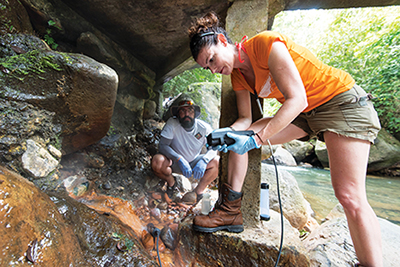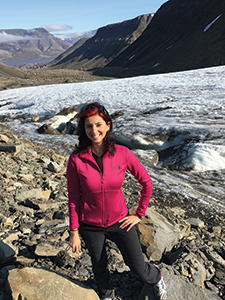Uncovering Microbial Mysteries
 Karen Lloyd spends most of her waking hours thinking about mud. Specifically, the mud at the bottom of the ocean and trying to determine how deep into the earth she can dig and still find something alive.
Karen Lloyd spends most of her waking hours thinking about mud. Specifically, the mud at the bottom of the ocean and trying to determine how deep into the earth she can dig and still find something alive.
“There is a vast and highly diverse microbial biosphere living under the ocean floor we hardly know anything about,” says Lloyd, assistant professor in the Department of Microbiology.
Microbes exist in every environment and often come from deep evolutionary branches of life. Uncovering the mysteries of these deep-sea microbes is changing how Lloyd and other scientists understand life on earth.
In the 1980s, scientists started using DNA to tell microbes apart. They sequenced the DNA of microbes and discovered they are more distantly related to each other than they are to humans. This revelation threw scientists for a loop. Three decades later, Lloyd and her colleagues had their own revelation.
“We discovered several new categories of microbes,” Lloyd says. “It’s really putting our assumptions of how all microbes are related to each other in disarray.”
Lloyd studies microbes across the globe – from Arctic fjords to Costa Rica subduction zones – and each project provides an opportunity for her graduate and undergraduate students to conduct research on a variety of topics.
In the Arctic fjords, Lloyd, two doctoral students, and an undergraduate student are examining the effects of climate change in the polar regions by studying microbes and marine sediments at the foot of receding glaciers. Microbial life actively changes its environment and leaves its impression in recently deposited sediment layers. By studying these layers, Lloyd and her students are able to get a snapshot of the earth across climactic changes. Understanding the current microbial activity and comparing it to how it changes with different types of sediment layers help Lloyd and her team learn more about the future of the planet.
 Lloyd’s project in Costa Rica, “Biology Meets Subduction,” involves a team of petrologists, geologists, geochemists, volcanologists, and microbiologists. Their goal is to understand the active subduction zone between the Caribbean and Cocos tectonic plates.
Lloyd’s project in Costa Rica, “Biology Meets Subduction,” involves a team of petrologists, geologists, geochemists, volcanologists, and microbiologists. Their goal is to understand the active subduction zone between the Caribbean and Cocos tectonic plates.
“In order to get at the question of how deep into the earth life actually goes, you need to have some interaction with people who understand how deep-earth processes work,” Lloyd says. “The whole point of this project is to get us working together to solve that question.”
An important aspect of the project is to study the interface of life and volcanic systems to understand how carbon cycles between the earth’s surface and interior in the active subduction zone that runs from Panama to Nicaragua. The movement of these tectonic plates is what causes earthquakes in Central America. Understanding how the movements happen and what gives rise to the deep-earth processes will aid in efforts of understanding the entire system and how it causes earthquakes, which are currently completely unpredictable.
“All of these geological processes are being affected by microbes, which are part of the puzzle that have been completely ignored,” Lloyd says. “It could be that there’s very little happening, but historically speaking, once we start looking at how microbes affect any environment, we discover they are behind a lot of the processes.”
Microbes fill every niche on earth – from the base of the Mariana Trench to the stratosphere. As Lloyd and her colleagues continue to find ways to study the highly diverse microbial systems, they will one day be able to provide the answer to what life, all of life, is like on earth.
Lloyd gave a TED Talk in Milan, Italy, about her research. View the talk below:

 Joy Buongiorno, a doctoral student in microbiology, studies the geological role of microbes. Her research with Lloyd in the Arctic fjords involves the intersection of biotic and abiotic processes, their characteristic traces in sediment layers, and the stories they may tell about the evolution of the environment in which microbes thrive. “As the glaciers retreat, we will most likely see a change in the geochemistry and microbial behavior. I hope my research yields a unique perspective on the way microbial communities beneath these glaciers change over long periods of time.”
Joy Buongiorno, a doctoral student in microbiology, studies the geological role of microbes. Her research with Lloyd in the Arctic fjords involves the intersection of biotic and abiotic processes, their characteristic traces in sediment layers, and the stories they may tell about the evolution of the environment in which microbes thrive. “As the glaciers retreat, we will most likely see a change in the geochemistry and microbial behavior. I hope my research yields a unique perspective on the way microbial communities beneath these glaciers change over long periods of time.”




